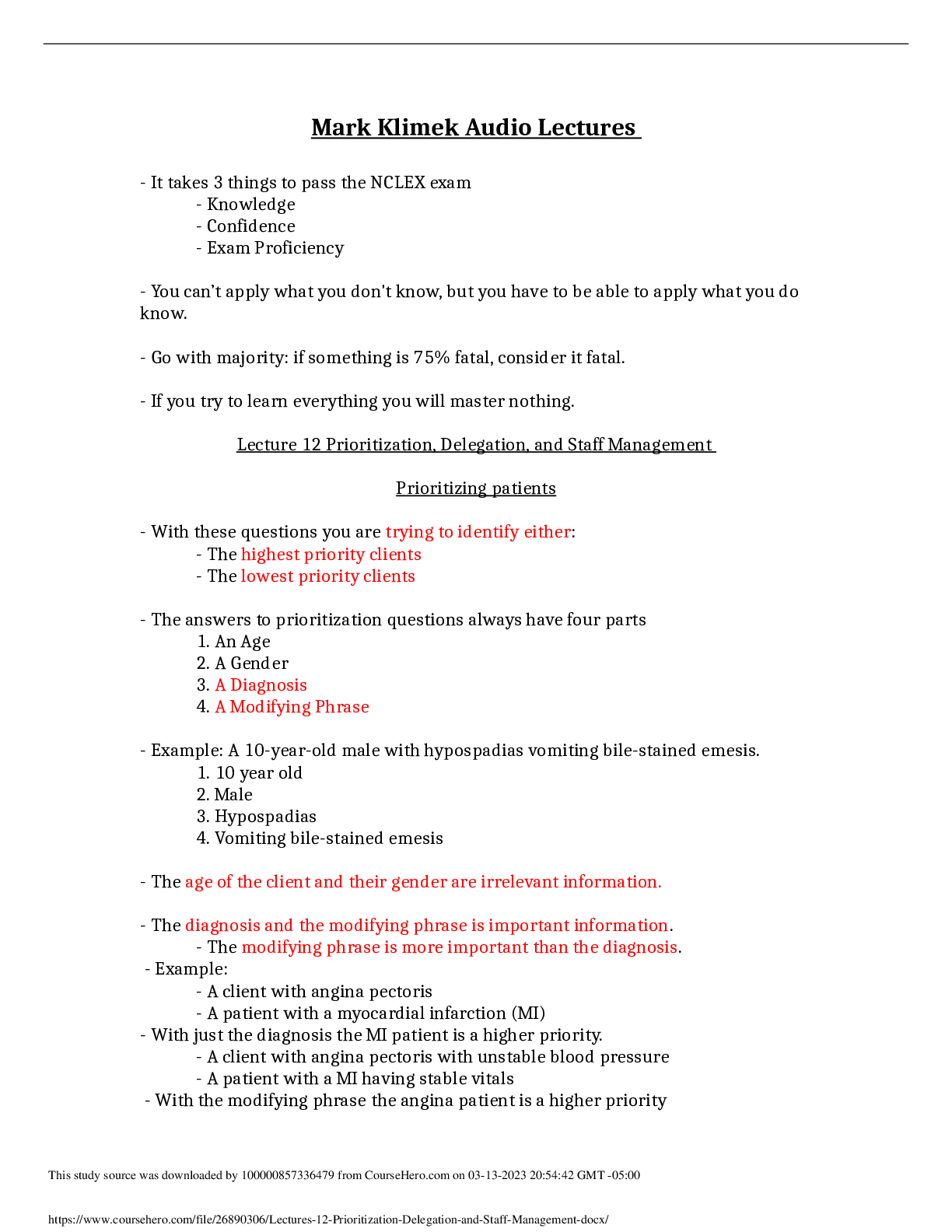Exam 4: Thyroid Disorder (NCLEX) | Questions, Answers and Rationales
Document Content and Description Below
Exam 4: Thyroid Disorder (NCLEX) | Questions, Answers and Rationales A nurse is collecting data regarding a client after a thyroidectomy and notes that the client has developed hoarseness and a weak ... voice. Which nursing action is appropriate? 1. Check for signs of bleeding. 2. Administer calcium gluconate. 3. Notify the registered nurse immediately. 4. Reassure the client that this is usually a temporary condition. Weakness and hoarseness of the voice can occur as a result of trauma of the laryngeal nerve. If this develops, the client should be reassured that the problem will subside in a few days. Unnecessary talking should be discouraged. It is not necessary to notify the registered nurse immediately. These signs do not indicate bleeding or the need to administer calcium gluconate. A nurse is caring for a postoperative parathyroidectomy client. Which of the following would require the nurse's immediate attention? 1. Incisional pain 2. Laryngeal stridor 3. Difficulty voiding 4. Abdominal cramps During the postoperative period, the nurse carefully observes the client for signs of hemorrhage, which cause swelling and the compression of adjacent tissue. Laryngeal stridor is a harsh, high-pitched sound heard on inspiration and expiration that is caused by the compression of the trachea and that leads to respiratory distress. It is an acute emergency situation that requires immediate attention to avoid the complete obstruction of the airway. A nurse assists in developing a plan of care for a client with hyperparathyroidism receiving calcitonin-human (Cibacalcin). Which outcome has the highest priority regarding this medication? 1. Relief of pain 2. Absence of side effects 3. Reaching normal serum calcium levels 4. Verbalization of appropriate medication knowledge Hypercalcemia can occur in clients with hyperparathyroidism, and calcitonin is used to lower plasma calcium level. The highest priority outcome in this client situation would be a reduction in serum calcium level. Option 1 is unrelated to this medication. Although options 2 and 4 are expected outcomes, they are not the highest priority for administering this medication. A nurse would expect to note which interventions in the plan of care for a client with hypothyroidism? Select all that apply. 1. Provide a cool environment for the client. 2. Instruct the client to consume a high-fat diet. 3. Instruct the client about thyroid replacement therapy. 4. Encourage the client to consume fluids and high-fiber foods in the diet. 5. Instruct the client to contact the health care provider if episodes of chest pain occur. 6. Inform the client that iodine preparations will be prescribed to treat the disorder. The clinical manifestations of hypothyroidism are the result of decreased metabolism from low levels of thyroid hormone. Interventions are aimed at replacement of the hormones and providing measures to support the signs and symptoms related to a decreased metabolism. The nurse encourages the client to consume a well-balanced diet that is low in fat for weight reduction and high in fluids and high-fiber foods to prevent constipation. The client often has cold intolerance and requires a warm environment. The client would notify the health care provider if chest pain occurs since it could be an indication of overreplacement of thyroid hormone. Iodine preparations are used to treat hyperthyroidism. These medications decrease blood flow through the thyroid gland and reduce the production and release of thyroid hormone. A nurse is caring for a client after thyroidectomy and monitoring for signs of thyroid storm. The nurse understands that which of the following is a manifestation associated with this disorder? 1. Bradycardia 2. Hypotension 3. Constipation 4. Hypothermia Clinical manifestations associated with thyroid storm include a fever as high as 106° F (41.1° C), severe tachycardia, profuse diarrhea, extreme vasodilation, hypotension, atrial fibrillation, hyperreflexia, abdominal pain, diarrhea, and dehydration. With this disorder, the client's condition can rapidly progress to coma and cardiovascular collapse. What would the nurse anticipate being included in the plan of care for a client who has been diagnosed with Graves' disease? 1. Provide a high-fiber diet. 2. Provide a restful environment. 3. Provide three small meals per day. 4. Provide the client with extra blankets. Because of the hypermetabolic state, the client with Graves' disease needs to be provided with an environment that is restful both physically and mentally. Six full meals a day that are well balanced and high in calories are required, because of the accelerated metabolic rate. Foods that increase peristalsis (e.g., high-fiber foods) need to be avoided. These clients suffer from heat intolerance and require a cool environment. Which statement by the client would cause the nurse to suspect that the thyroid test results drawn on the client this morning may be inaccurate? 1. "I had a radionuclide test done 3 days ago." 2. "When I exercise I sweat more than normal." 3. "I drank some water before the blood was drawn." 4. "That hamburger I ate before the test sure tasted good." Option 1 indicates that a recent radionuclide scan had been performed. Recent radionuclide scans performed before the test can affect thyroid laboratory results. No food, fluid, or activity restrictions are required for this test, so options 2, 3, and 4 are incorrect. A nurse is caring for a client with a diagnosis of hypoparathyroidism. The nurse reviews the laboratory results drawn on the client and notes that the calcium level is extremely low. The nurse would expect to note which of the following on data collection of the client? 1. Positive Trousseau's sign 2. Negative Chvostek's sign 3. Unresponsive pupils 4. Hyperactive bowel sounds Hypoparathyroidism is related to a lack of parathyroid hormone secretion or to a decreased effectiveness of parathyroid hormone on target tissues. The end result of this disorder is hypocalcemia. When serum calcium levels are critically low, the client may exhibit positive Chvostek's and Trousseau's signs, which indicate potential tetany. Options 2, 3, and 4 are not related to the presence of hypocalcemia. A health care provider has prescribed propylthiouracil (PTU) for a client with hyperthyroidism, and the nurse assists in developing a plan of care for the client. A priority nursing measure to be included in the plan regarding this medication is to monitor the client for: 1. Signs and symptoms of hypothyroidism 2. Signs and symptoms of hyperglycemia 3. Relief of pain 4. Signs of renal toxicity Excessive dosing with propylthiouracil may convert the client from a hyperthyroid state to a hypothyroid state. If this occurs, the dosage should be reduced. Temporary administration of thyroid hormone may be required. Propylthiouracil is not used for pain and does not cause hyperglycemia or renal toxicity. A client with Graves' disease has exophthalmos and is experiencing photophobia. Which intervention would best assist the client with this problem? 1. Administering methimazole (Tapazole) every 8 hours 2. Lubricating the eyes with tap water every 2 to 4 hours 3. Instructing the client to avoid straining or heavy lifting 4. Obtaining dark glasses for the client Because photophobia (light intolerance) accompanies this disorder, dark glasses are helpful in alleviating the symptom. Medical therapy for Graves' disease does not help alleviate the clinical manifestation of exophthalmos. Other interventions may be used to relieve the drying that occurs from not being able to completely close the eyes; however, the question is asking what the nurse can do for photophobia. Tap water, which is hypotonic, could actually cause more swelling to the eye because it could pull fluid into the interstitial space. In addition, the client is at risk for developing an eye infection because the solution is not sterile. There is no need to prevent straining with exophthalmos. The nurse caring for a client who has had a subtotal thyroidectomy reviews the plan of care and determines which problem is the priority for this client in the immediate postoperative period? 1. Dehydration 2. Infection 3. Urinary retention 4. Bleeding Hemorrhage is one of the most severe complications that can occur following thyroidectomy. The nurse must frequently check the neck dressing for bleeding and monitor vital signs to detect early signs of hemorrhage, which could lead to shock. T3 and T4 do not regulate fluid volumes in the body. Infection is a concern for any postoperative client but is not the priority in the immediate postoperative period. Urinary retention can occur in postoperative clients as a result of medication and anesthesia but is not the priority from the options provided. A nurse is collecting data on a client admitted to the hospital with a diagnosis of myxedema. Which data collection technique will provide data necessary to support the admitting diagnosis? 1. Auscultation of lung sounds 2. Inspection of facial features 3. Percussion of the thyroid gland 4. Palpation of the adrenal glands Inspection of facial features will reveal the characteristic coarse features, presence of edema around the eyes and face, and a blank expression that are characteristic of myxedema. The techniques in the remaining options will not reveal any data that would support the diagnosis of myxedema. A nurse reviews a plan of care for a postoperative client following a thyroidectomy and notes that the client is at risk for breathing difficulty. Which of the following nursing interventions will the nurse suggest to include in the plan of care? 1. Maintain a supine position. 2. Encourage coughing and deep breathing exercises. 3. Monitor neck circumference frequently. 4. Maintain a pressure dressing on the operative site. Following a thyroidectomy, the client should be placed in an upright position to facilitate air exchange. The nurse should assist the client with deep breathing exercises, but coughing is minimized to prevent tissue damage and stress to the incision. A pressure dressing is not placed on the operative site because it could affect breathing. The nurse should monitor the dressing closely and should loosen the dressing if necessary. Neck circumference is monitored at least every 4 hours to assess for postoperative edema. A nurse is monitoring a client following a thyroidectomy for signs of hypocalcemia. Which of the following signs, if noted in the client, likely indicates the presence of hypocalcemia? 1. Tingling around the mouth 2. Negative Chvostek's sign 3. Flaccid paralysis 4. Bradycardia Following a thyroidectomy, the nurse assesses the client for signs of hypocalcemia and tetany. Early signs include tingling around the mouth and fingertips, muscle twitching or spasms, palpitations or dysrhythmias, and positive Chvostek's and Trousseau's signs. Options 2, 3, and 4 are not signs of hypocalcemia. A nurse is caring for a client following a thyroidectomy. The client tells the nurse that she is concerned because of voice hoarseness. The client asks the nurse whether the hoarseness will subside. The nurse appropriately tells the client that the hoarseness: 1. Indicates nerve damage 2. Is harmless but permanent 3. Will worsen before it subsides 4. Is normal and will gradually subside Hoarseness that develops in the postoperative period is usually the result of laryngeal pressure or edema and will resolve within a few days. The client should be reassured that the effects are transitory. Options 1, 2, and 3 are incorrect. A nurse is monitoring a client with Graves' disease for signs of thyrotoxic crisis (thyroid storm). Which of the following signs and symptoms, if noted in the client, will alert the nurse to the presence of this crisis? Select all that apply. 1. Bradycardia 2. Fever 3. Sweating 4. Agitation 5. Pallor Thyrotoxic crisis (thyroid storm) is an acute, potentially life-threatening state of extreme thyroid activity that represents a breakdown in the body's tolerance to a chronic excess of thyroid hormones. The clinical manifestations include fever greater than 100° F, severe tachycardia, flushing and sweating, and marked agitation and restlessness. Delirium and coma can occur. Which of the following clients is at risk for developing thyrotoxicosis? 1. A client with hypothyroidism 2. A client with Graves' disease who is having surgery 3. A client with diabetes mellitus scheduled for debridement of a foot ulcer 4. A client with diabetes insipidus scheduled for an invasive diagnostic test Thyrotoxicosis is usually seen in clients with Graves' disease with the symptoms precipitated by a major stressor. This complication typically occurs during periods of severe physiological or psychological stress such as trauma, sepsis, the birth process, or major surgery. It also must be recognized as a potential complication following a thyroidectomy. A nurse is caring for a client diagnosed with hyperparathyroidism who is prescribed furosemide (Lasix). The nurse reinforces dietary instructions to the client. Which of the following is an appropriate instruction? 1. Increase dietary intake of calcium. 2. Drink at least 2 to 3 L of fluid daily. 3. Eat sparely when experiencing nausea. 4. Decrease dietary intake of potassium. The aim of treatment in the client with hyperparathyroidism is to increase the renal excretion of calcium and decrease gastrointestinal absorption and bone resorption. This is aided by the sufficient intake of fluids. Dietary restriction of calcium may be used as a component of therapy. The parathyroid is responsible for calcium production, and the term, "hyperparathyroidism" can be indicative of an increase in calcium. The client should eat foods high in potassium, especially if the client is taking furosemide. Limiting nutrients is not advisable. A nurse has reinforced instructions to the client with hyperparathyroidism regarding home care measures related to exercise. Which statement by the client indicates a need for further instruction? Select all that apply. 1. "I enjoy exercising but I need to be careful." 2. "I need to pace my activities throughout the day." 3. "I need to limit playing football to only the weekends." 4. "I should gauge my activity level by my energy level." 5. "I should exercise in the evening to encourage a good sleep pattern." The client should be instructed to avoid high-impact activity or contact sports such as football. Exercising late in the evening may interfere with restful sleep. The client with hyperparathyroidism should pace activities throughout the day and plan for periods of uninterrupted rest. The client should plan for at least 30 minutes of walking each day to support calcium movement into the bones. The client should be instructed to use energy level as a guide to activity. A nurse has reinforced dietary instructions to a client with a diagnosis of hypoparathyroidism. The nurse instructs the client to include which of the following items in the diet? 1. Vegetables 2. Meat 3. Fish 4. Cereals The client with hypoparathyroidism is instructed to follow a calcium-rich diet and to restrict the amount of phosphorus in the diet. The client should limit meat, poultry, fish, eggs, cheese, and cereals. Vegetables are allowed in the diet. A nurse is caring for a client experiencing thyroid storm. Which of the following would be a priority concern for this client? 1. Inability to cope with the treatment plan 2. Lack of sexual drive 3. Self-consciousness about body appearance 4. Potential for cardiac disturbances Clients in thyroid storm are experiencing a life-threatening event, which is associated with uncontrolled hyperthyroidism. It is characterized by high fever, severe tachycardia, delirium, dehydration, and extreme irritability. The signs and symptoms of the disorder develop quickly, and therefore emergency measures must be taken to prevent death. These measures include maintaining hemodynamic status and patency of airway as well as providing adequate ventilation. Options 1, 2, and 3 are not a priority in the care of the client in thyroid storm. A nurse is collecting data on a client with hyperparathyroidism. Which of the following questions would elicit the accurate information about this condition from the client? 1. "Do you have tremors in your hands?" 2. "Are you experiencing pain in your joints?" 3. "Have you had problems with diarrhea lately?" 4. "Do you notice swelling in your legs at night?" Hyperparathyroidism causes an oversecretion of parathyroid hormone (PTH), which causes excessive osteoblast growth and activity within the bones. When bone reabsorption is increased, calcium is released from the bones into the blood, causing hypercalcemia. The bones suffer demineralization as a result of calcium loss, leading to bone and joint pain, and pathological fractures. A client with myxedema has changes in intellectual function such as impaired memory, decreased attention span, and lethargy. The client's husband is upset and shares his concerns with the nurse. Which statement by the nurse is helpful to the client's husband? 1. "Would you like me to ask the health care provider for a prescription for a stimulant?" 2. "Give it time. I've seen dozens of clients with this problem that fully recover." 3. "I don't blame you for being frustrated, because the symptoms will only get worse." 4. "It's obvious that you are concerned about your wife's condition, but the symptoms may improve with continued therapy." Using therapeutic communication techniques, the nurse acknowledges the husband's concerns and conveys that the client's symptoms are common with myxedema. With thyroid hormone therapy, these symptoms should decrease, and cognitive function often returns to normal. Option 1 is not helpful, and it blocks further communication. Option 3 is pessimistic and untrue. Option 2 is not appropriate and offers false reassurance. A client with hypoparathyroidism has hypocalcemia. The nurse avoids giving the client the prescribed vitamin and calcium supplement with which of the following liquids? 1. Milk 2. Water 3. Iced tea 4. Fruit juice Milk products are high in phosphates, which should be avoided by a client with hypoparathyroidism. Otherwise, calcium products are best absorbed with milk because the vitamin D in the milk promotes calcium absorption. An older client with a history of hyperparathyroidism and severe osteoporosis is hospitalized. The nurse caring for the client plans first to address which problem? 1. The possibility of injury 2. Constipation 3. Urinary retention 4. Need for teaching about the disorder The client with severe osteoporosis as a result of hyperparathyroidism is at risk for injury as a result of pathological fractures that can occur from bone demineralization. The client may also have a risk for constipation from the disease process but this is a lesser priority than client safety. The client may or may not have urinary elimination problems, depending on other factors in the client's history. There is no information in the question to support whether the client needs teaching. A client has been diagnosed with hypoparathyroidism. The nurse teaches the client to include foods in the diet that are: 1. High in phosphorus and low in calcium 2. Low in phosphorus and low in calcium 3. Low in phosphorus and high in calcium 4. High in phosphorus and high in calcium Hypoparathyroidism results in hypocalcemia. A therapeutic diet for this disorder is one that is high in calcium but low in phosphorus because these two electrolytes have inverse proportions in the body. All of the other options are unrelated to this disorder and are incorrect. A client scheduled for a thyroidectomy says to the nurse, "I am so scared to get cut in my neck." Based on the client's statement, the nurse determines that the client is experiencing which problem? 1. Inadequate knowledge about the surgical procedure 2. Fear about impending surgery 3. Embarrassment about the changes in personal appearance 4. Lack of support related to the surgical procedure The client is having a difficult time coping with the scheduled surgery. The client is able to express fears but is scared. No data in the question support options 1, 3, and 4. A nurse is collecting data on a client with a diagnosis of hypothyroidism. Which of these behaviors, if present in the client's history, would the nurse determine as being likely related to the manifestations of this disorder? 1. Depression 2. Nervousness 3. Irritability 4. Anxiety Hypothyroid clients experience a slow metabolic rate, and its manifestation includes apathy, fatigue, sleepiness, and depression. Options 2, 3, and 4 identify the clinical manifestations of hyperthyroidism. A nurse is caring for a client with hypothyroidism who is overweight. Which food items would the nurse suggest to include in the plan? 1. Peanut butter, avocado, and red meat 2. Skim milk, apples, whole-grain bread, and cereal 3. Organ meat, carrots, and skim milk 4. Seafood, spinach, and cream cheese Clients with hypothyroidism may have a problem with being over-weight because of their decreased metabolic need. They should consume foods from all food groups, which will provide them with the necessary nutrients; however, the foods should be low in calories. Option 2 is the only option that identifies food items that are low in calories. A nurse working on an endocrine nursing unit understands that which correct concept is used in planning care? 1. Clients with Cushing's syndrome are likely to experience episodic hypotension. 2. Clients with hyperthyroidism must be monitored for weight gain. 3. Clients who have diabetes insipidus should be assessed for fluid excess. 4. Clients who have hyperparathyroidism should be protected against falls. Hyperparathyroidism is a disease that involves excess secretion of parathyroid hormone (PTH). Elevation of PTH causes excess calcium to be removed from the bones. There is a decline in bone mass, which may cause a fracture if a fall occurs. Cushing's syndrome is likely to cause hypertension. Clients with hypothyroidism must be monitored for weight gain and clients with hyperthyroidism must be monitored for weight loss. Clients who have diabetes insipidus should be assessed for fluid deficit. A nurse is collecting data from a client who is being admitted to the hospital for a diagnostic workup for primary hyperparathyroidism. The nurse understands that which client complaint would be characteristic of this disorder? 1. Diarrhea 2. Polyuria 3. Polyphagia 4. Weight gain Hypercalcemia is the hallmark of hyperparathyroidism. Elevated serum calcium levels produce osmotic diuresis (polyuria). This diuresis leads to dehydration and the client would lose weight. Options 1, 3, and 4 are gastrointestinal (GI) symptoms but are not associated with the common GI symptoms typical of hyperparathyroidism (nausea, vomiting, anorexia, constipation). A nurse is preparing to discharge a client who has had a parathyroidectomy. When teaching the client about the prescribed oral calcium supplement, what information should the nurse include? 1. Take the calcium 30 to 60 minutes following a meal. 2. Avoid sunlight because it can cause skin color change. 3. Store the calcium in the refrigerator to maintain potency. 4. Check the pulse daily and hold the dosage if it is below 60 beats per minute. Oral calcium supplements can be taken 30 to 60 minutes after meals to enhance their absorption and decrease gastrointestinal irritation. All the other options are unrelated to oral calcium therapy. A client has just been admitted with a diagnosis of myxedema coma. If all of the following interventions were prescribed, the nurse would place highest priority on completing which of the following first? 1. Administering oxygen 2. Administering thyroid hormone 3. Warming the client 4. Giving fluid replacement As part of maintaining a patent airway, oxygen would be administered first. This would be quickly followed by fluid replacement, keeping the client warm, monitoring vital signs, and administering thyroid hormones. The client is diagnosed with hypothyroidism. Which signs/symptoms should the nurse expect the client to exhibit? 1. Complaints of extreme fatigue and hair loss. 2. Exophthalmos and complaints of nervousness. 3. Complaints of profuse sweating and flushed skin. 4. Tetany and complaints of stiffness of the hands. The nurse identifies the client problem "risk for imbalanced body temperature" fort he client diagnosed with hypothyroidism. Which intervention should be included in the plan of care? 1. Discourage the use of an electric blanket. 2. Assess the client's temperature every two (2) hours. 3. Keep the room temperature cool. 4. Space activities to promote rest. External heat sources (heating pads, electric or warming blankets) should be discouraged because they increase the risk of peripheral vasodilation and vascular collapse. The client diagnosed with hypothyroidism is prescribed the thyroid hormone levothyroxine (Synthroid). Which assessment data indicate the medication has been effective? 1. The client has a three (3)-pound weight gain. 2. The client has a decreased pulse rate. 3. The client's temperature is WNL. 4. The client denies any diaphoresis. The client with hypothyroidism frequently has a subnormal temperature, so a temperature WNL indicates the medication is effective. Which nursing intervention should be included in the plan of care for the client diagnosed with hyperthyroidism? 1. Increase the amount of fiber in the diet. 2. Encourage a low-calorie, low-protein diet. 3. Decrease the client's fluid intake to 1,000 mL/day. 4. Provide six (6) small, well-balanced meals a day. The client with hyperthyroidism has an increased appetite; therefore, well-balanced meals served several times throughout the day will help with the client's constant hunger The client is admitted to the intensive care department diagnosed with myxedemacoma. Which assessment data warrant immediate intervention by the nurse? 1. Serum blood glucose level of 74 mg/dL. 2. Pulse oximeter reading of 90%. 3. Telemetry reading showing sinus bradycardia. 4. The client is lethargic and sleeps all the time. A pulse oximeter reading of less than 93% is significant. A 90% pulse oximeter reading indicates a PaO2 of approximately 60 on an arterial blood gas test; this is severe hypoxemia and requires immediate intervention. Which medication order should the nurse question in the client diagnosed with untreated hypothyroidism? 1. Thyroid hormones. 2. Oxygen. 3. Sedatives. 4. Laxatives. Untreated hypothyroidism is characterized by an increased susceptibility to the effects of most hypnotic and sedative agents; therefore, the nurse should question this medication. Which statement made by the client makes the nurse suspect the client is experiencing hyperthyroidism? 1. "I just don't seem to have any appetite anymore." 2. "I have a bowel movement about every 3 to 4 days." 3. "My skin is really becoming dry and coarse." 4. "I have noticed all my collars are getting tighter." The thyroid gland (in the neck) en-larges as a result of the increased need for thyroid hormone production; an enlarged gland is called a goiter. The 68-year-old client diagnosed with hyperthyroidism is being treated with radio active iodine therapy. Which interventions should the nurse discuss with the client? 1. Explain it will take up to a month for symptoms of hyperthyroidism to subside. 2. Teach the iodine therapy will have to be tapered slowly over one (1) week. 3. Discuss the client will have to be hospitalized during the radioactive therapy. 4. Inform the client after therapy the client will not have to take any medication. Radioactive iodine therapy is used to destroy the overactive thyroid cells. After treatment, the client is followed closely for three (3) to four (4) weeks until the euthyroid state is reached. The nurse is teaching the client diagnosed with hyperthyroidism. Which information should be taught to the client? Select all that apply. 1. Notify the HCP if a three (3)-pound weight loss occurs in two (2) days. 2. Discuss ways to cope with the emotional lability. 3. Notify the HCP if taking over-the-counter medication 4. Carry a medical identification card or bracelet. 5. Teach how to take thyroid medications correctly. Weight loss indicates the medication may not be effective and will probably need to be increased. The client needs to know emotional highs and lows are secondary to hyperthyroidism. With treatment, this emotional lability will subside. Any over-the-counter medications (for example, alcohol-based medications) may negatively affect the client's hyperthyroidism or medications being used for treatment. This will help any HCP immediately know of the client's condition, especially if the client is unable to tell the HCP. The client will be on anti thyroid medication not thyroid medication The nurse is providing an in-service on thyroid disorders. One of the attendees asks the nurse, "Why don't the people in the United States get goiters as often?" Which statement by the nurse is the best response? 1. "It is because of the screening techniques used in the United States." 2. "It is a genetic predisposition rare in North Americans." 3. "The medications available in the United States decrease goiters." 4. "Iodized salt helps prevent the development of goiters in the United States." Almost all of the iodine entering the body is retained in the thyroid gland. A deficiency in iodine will cause the thyroid gland to work hard and enlarge, which is called a goiter. Goiters are commonly seen in geographical regions having an iodine deficiency. Most table salt in the United States has iodine added. The nurse is preparing to administer the following medications. Which medication should the nurse question administering? 1. The thyroid hormone to the client who does not have a T3, T4 level. 2. The regular insulin to the client with a blood glucose level of 210 mg/dL. 3. The loop diuretic to the client with a potassium level of 3.3 mEq/L. 4. The cardiac glycoside to the client who has a digoxin level of 1.4 mg/dL. This potassium level is below normal,which is 3.5 to 5.5 mEq/L. Therefore,the nurse should question administering this medication because loop diuretics cause potassium loss in the urine. Which signs/symptoms should make the nurse suspect the client is experiencing a thyroid storm? 1. Obstipation and hypoactive bowel sounds. 2. Hyperpyrexia and extreme tachycardia. 3. Hypotension and bradycardia. 4. Decreased respirations and hypoxia. Hyperpyrexia (high fever) and heart rate above 130 beats per minute are signs of thyroid storm, a severely exaggerated hyperthyroidism. A client is admitted to an emergency department, and a diagnosis of myxedema coma is made. Which action would the nurse prepare to carry out initially? 1. Warm the client. 2.Maintain a patent airway. [Show More]
Last updated: 1 year ago
Preview 1 out of 43 pages

Loading document previews ...
Buy this document to get the full access instantly
Instant Download Access after purchase
Buy NowInstant download
We Accept:

Reviews( 0 )
$20.00
Can't find what you want? Try our AI powered Search
Document information
Connected school, study & course
About the document
Uploaded On
Aug 07, 2024
Number of pages
43
Written in
All
Additional information
This document has been written for:
Uploaded
Aug 07, 2024
Downloads
0
Views
86


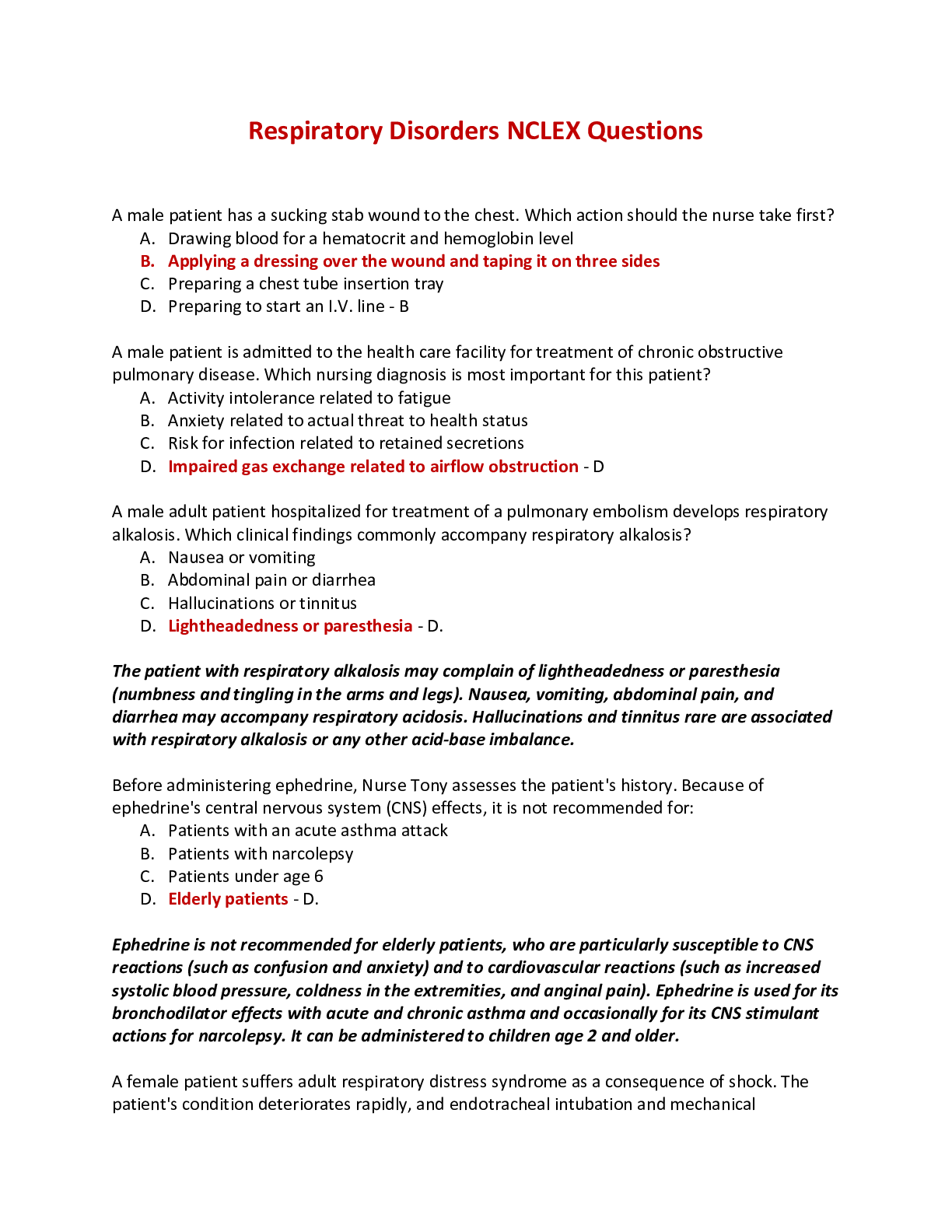
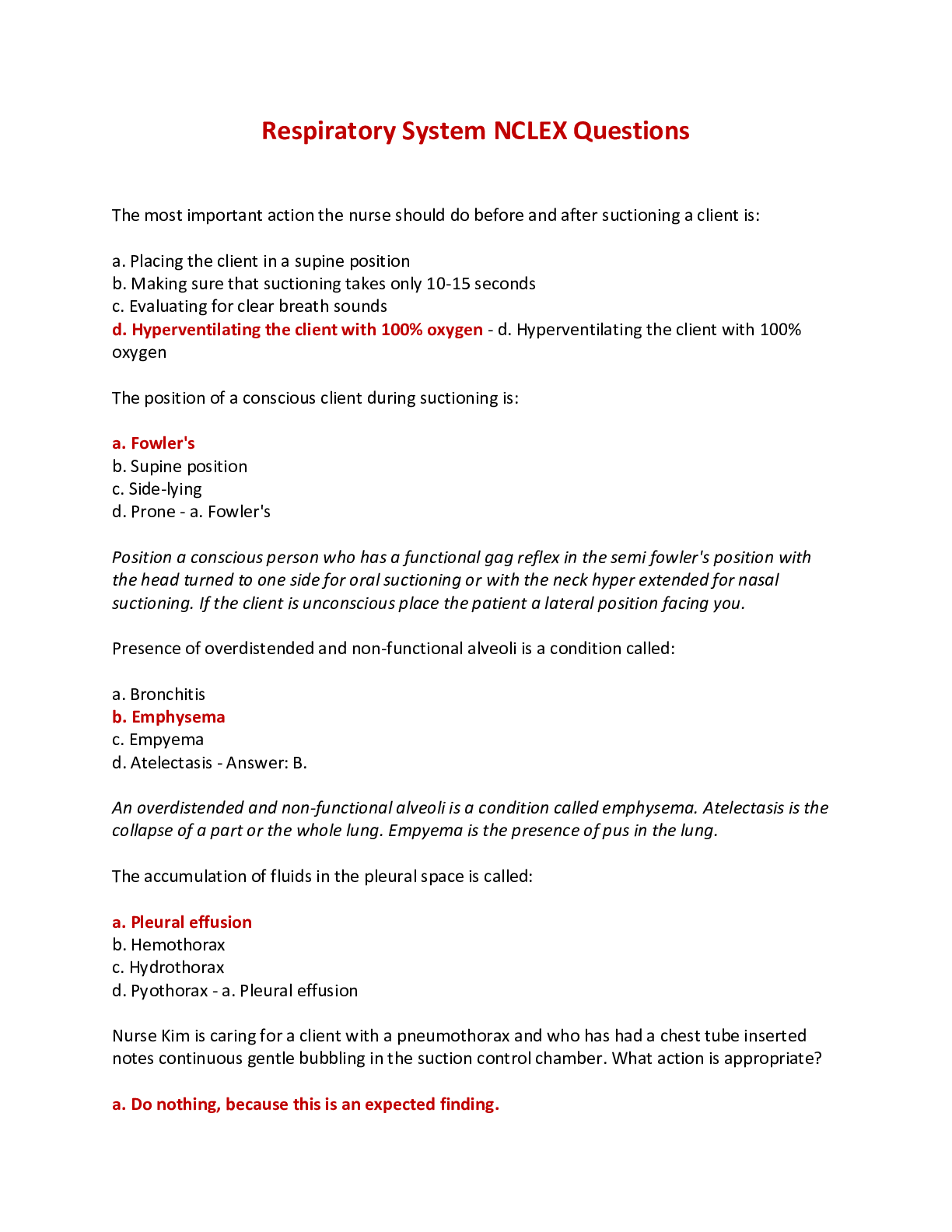
 NCLEX Study Guide.png)
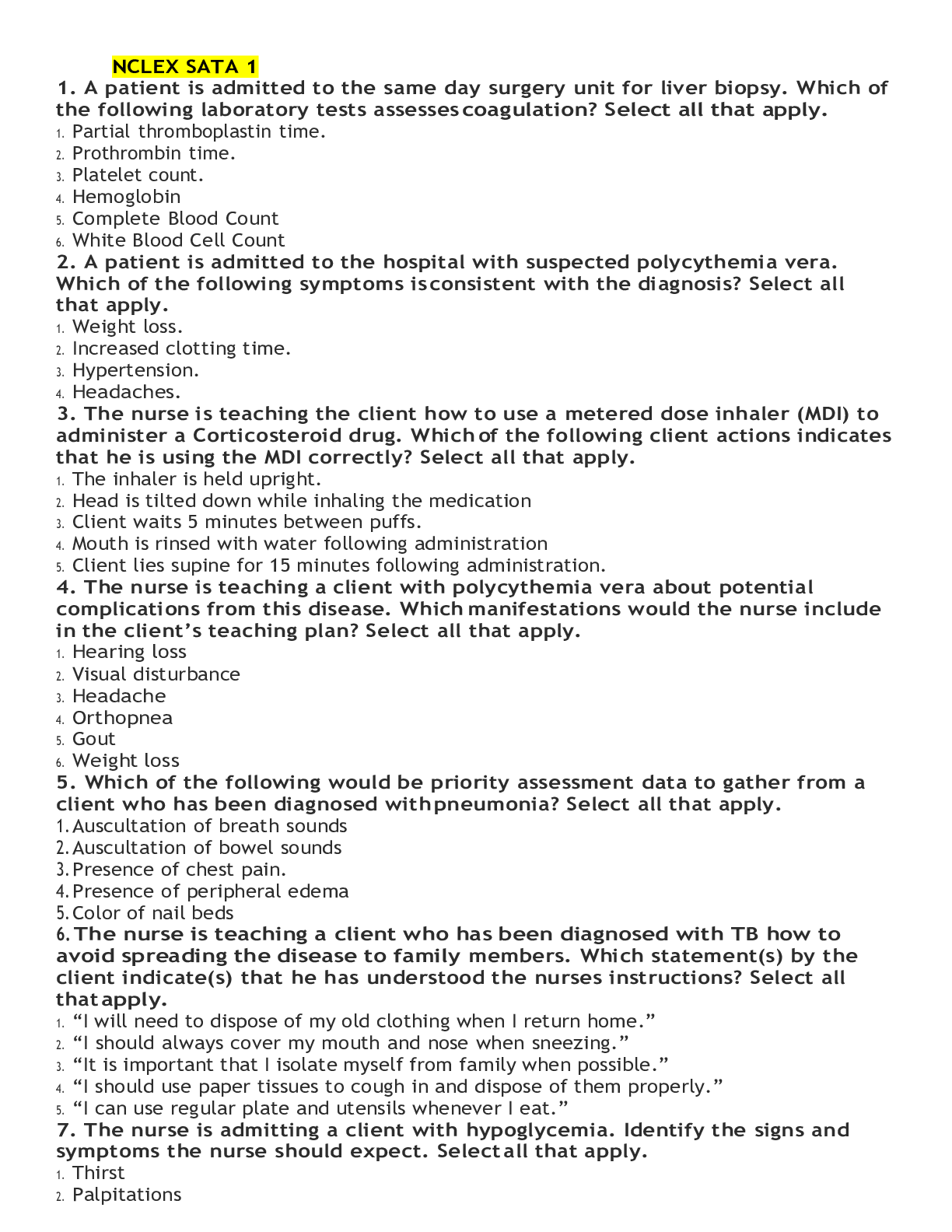

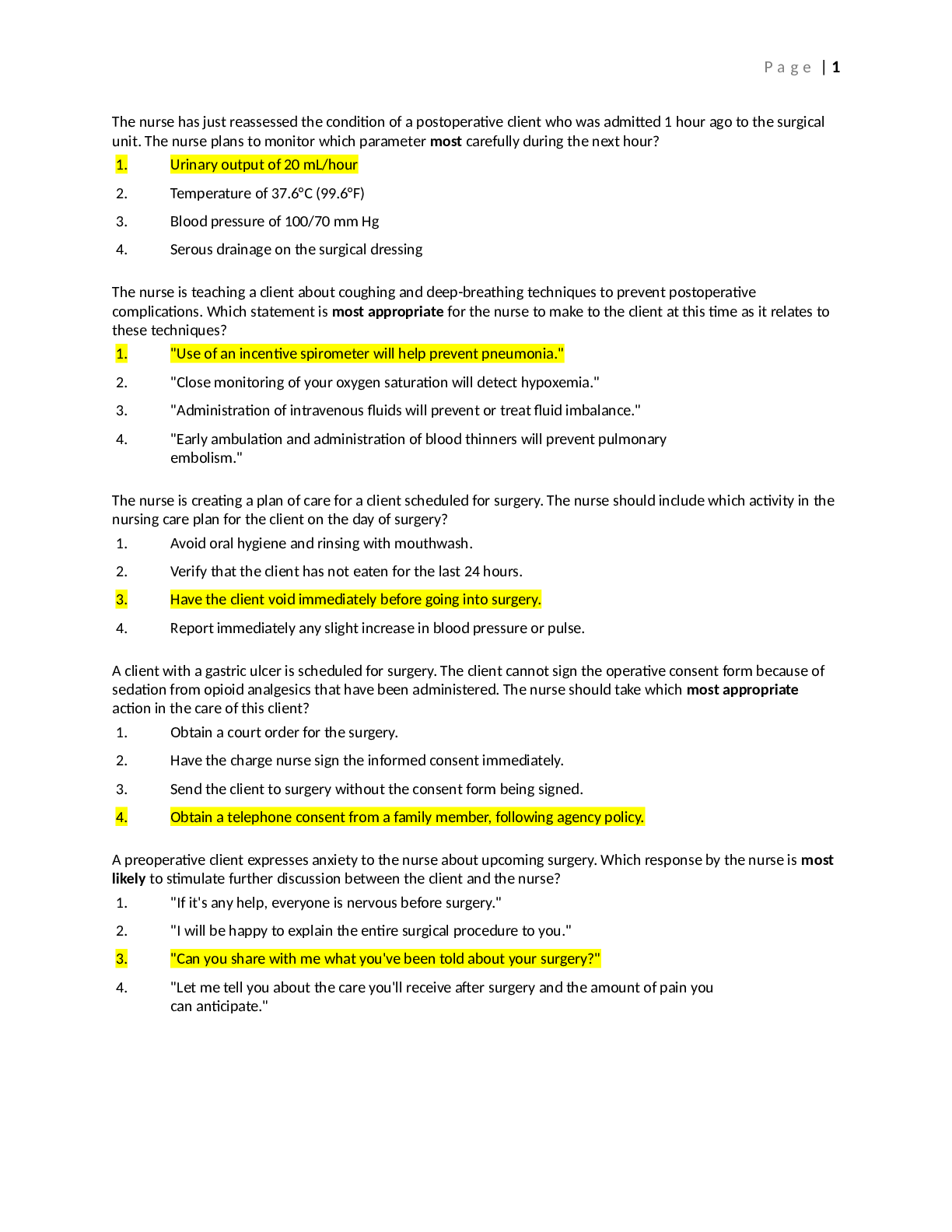


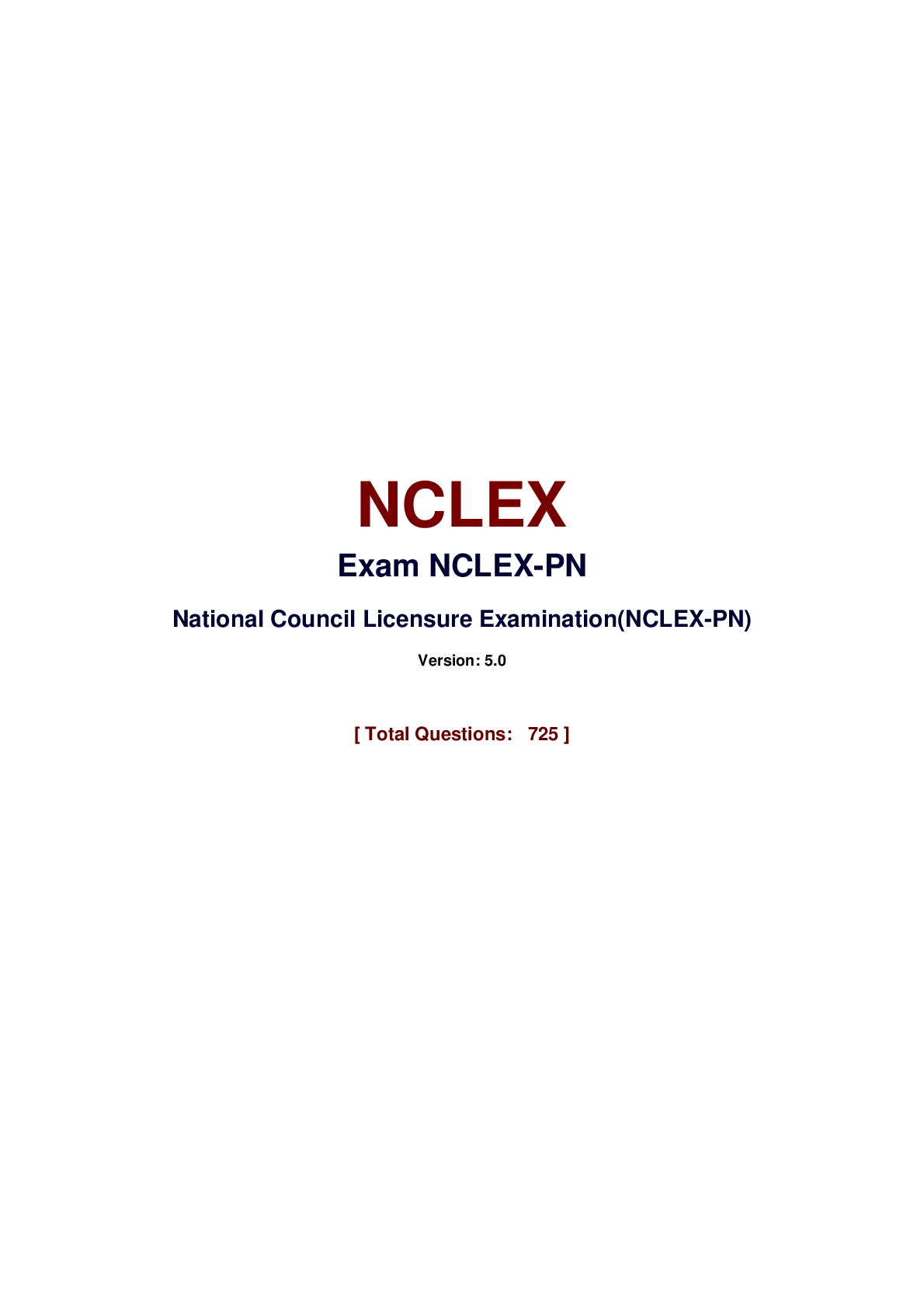




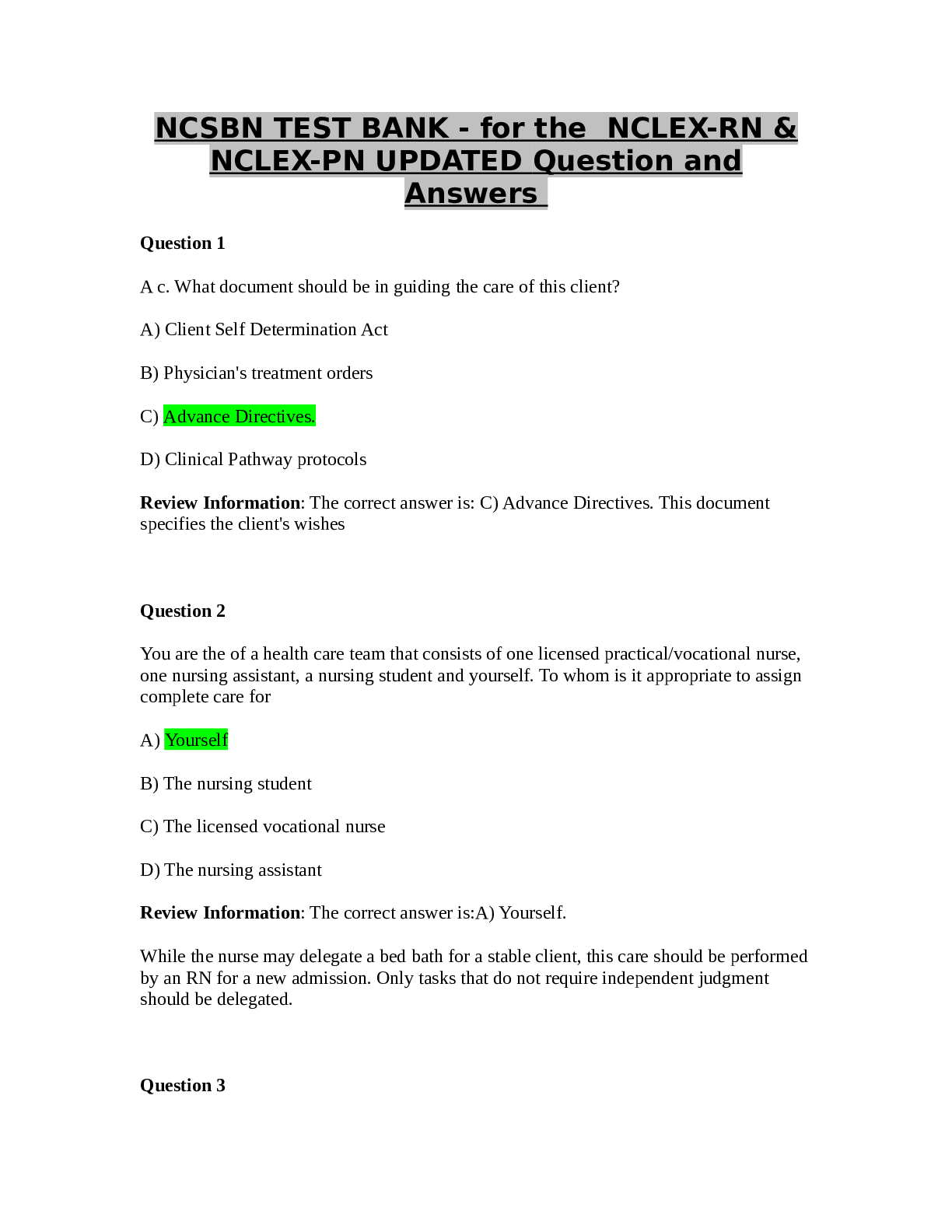
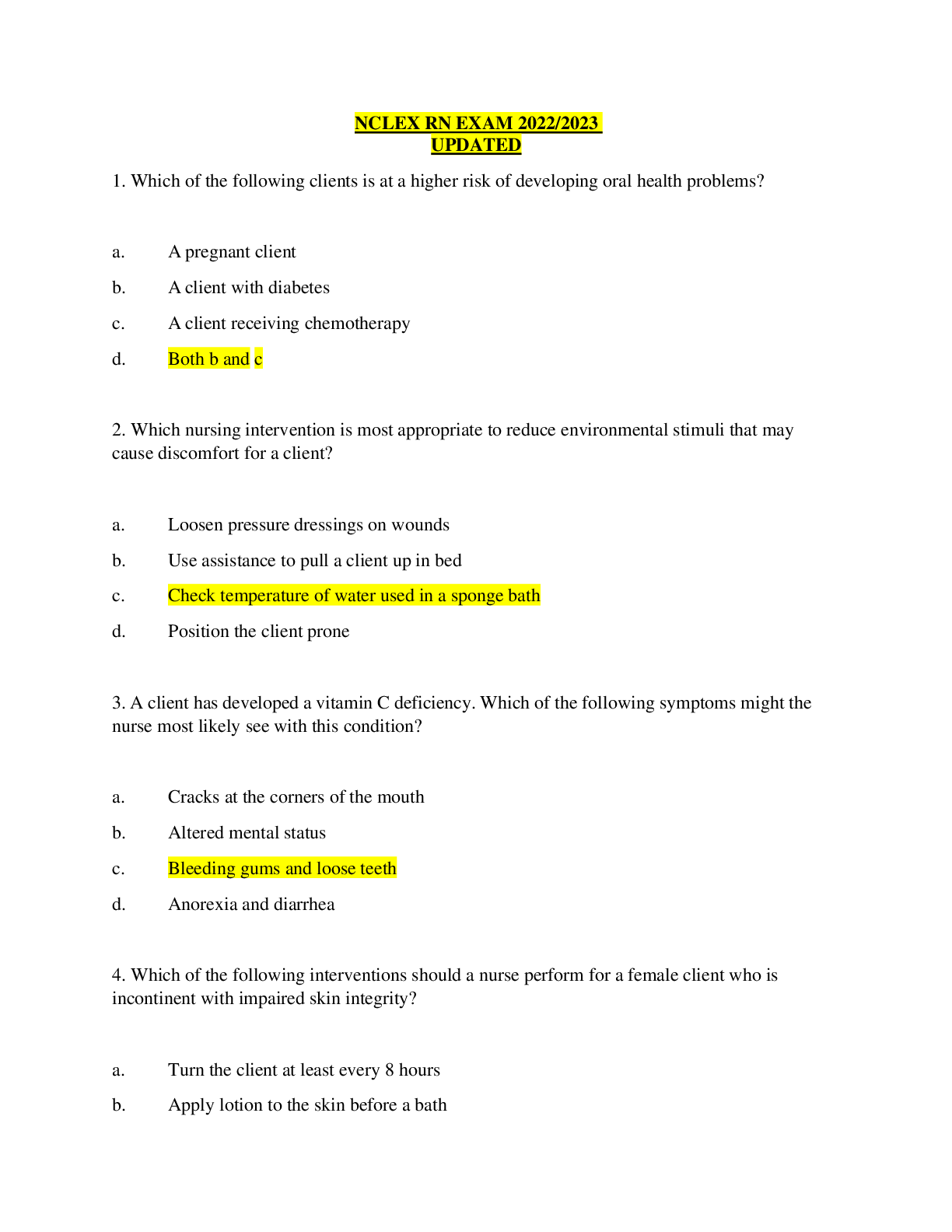
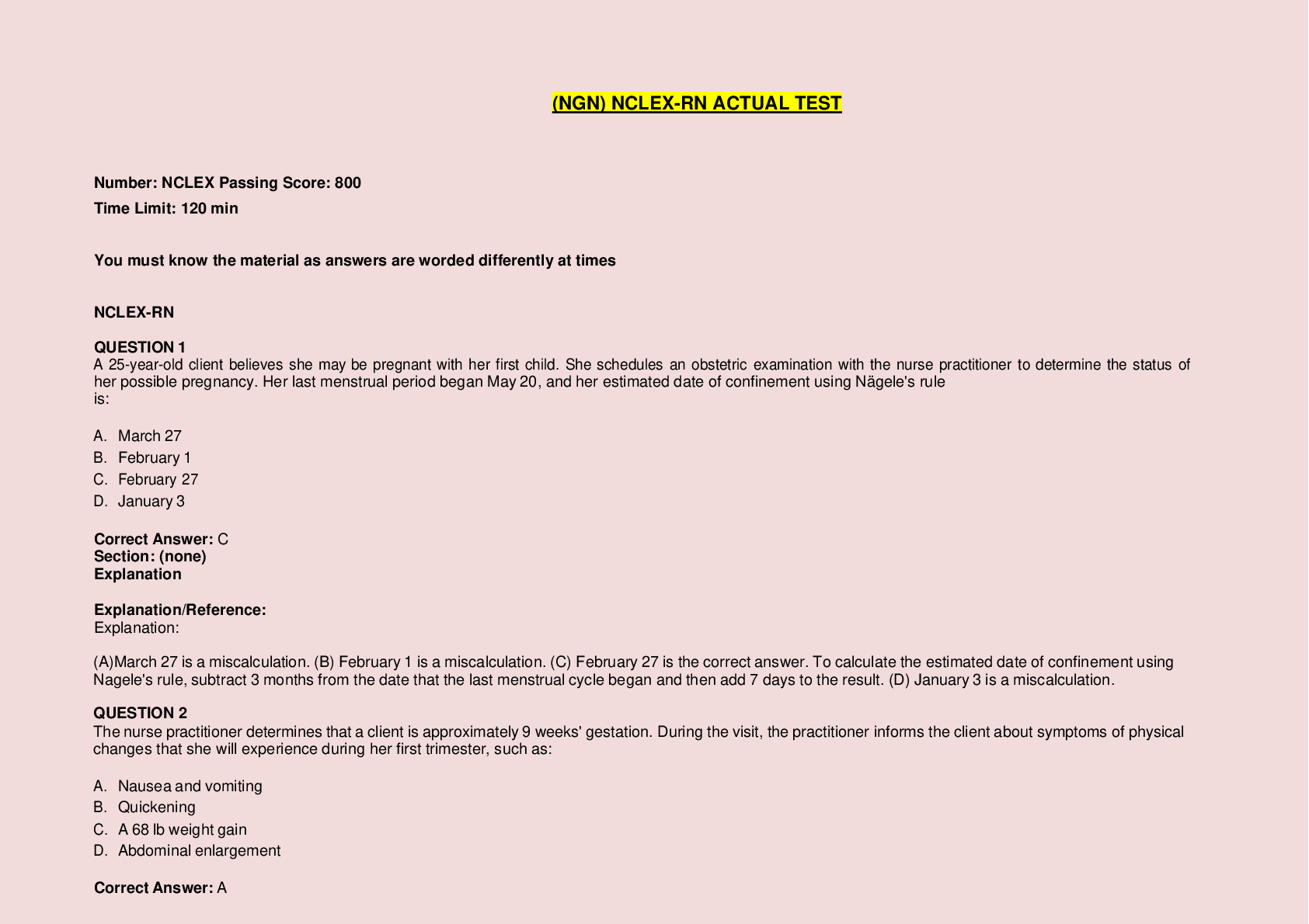
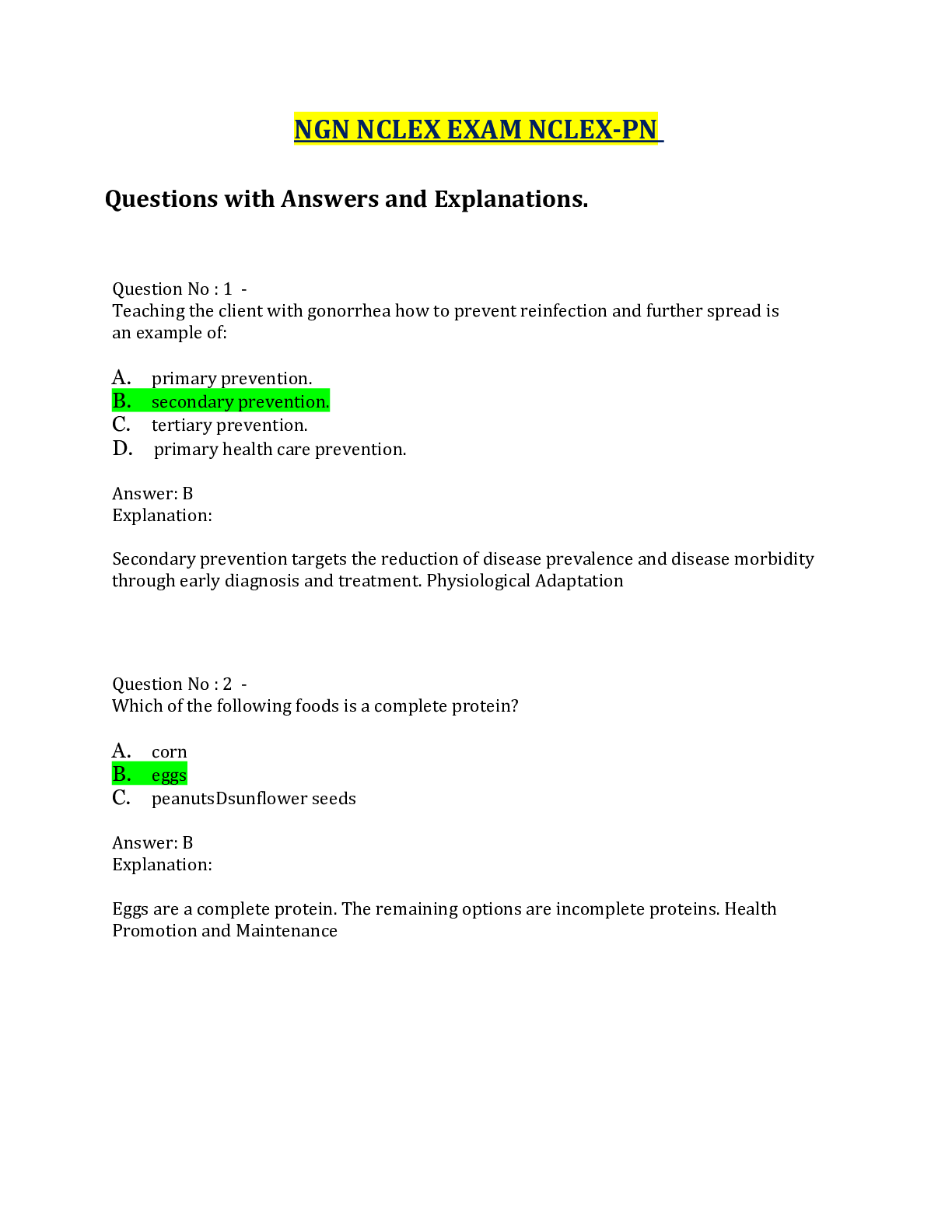

 JN21.png)
